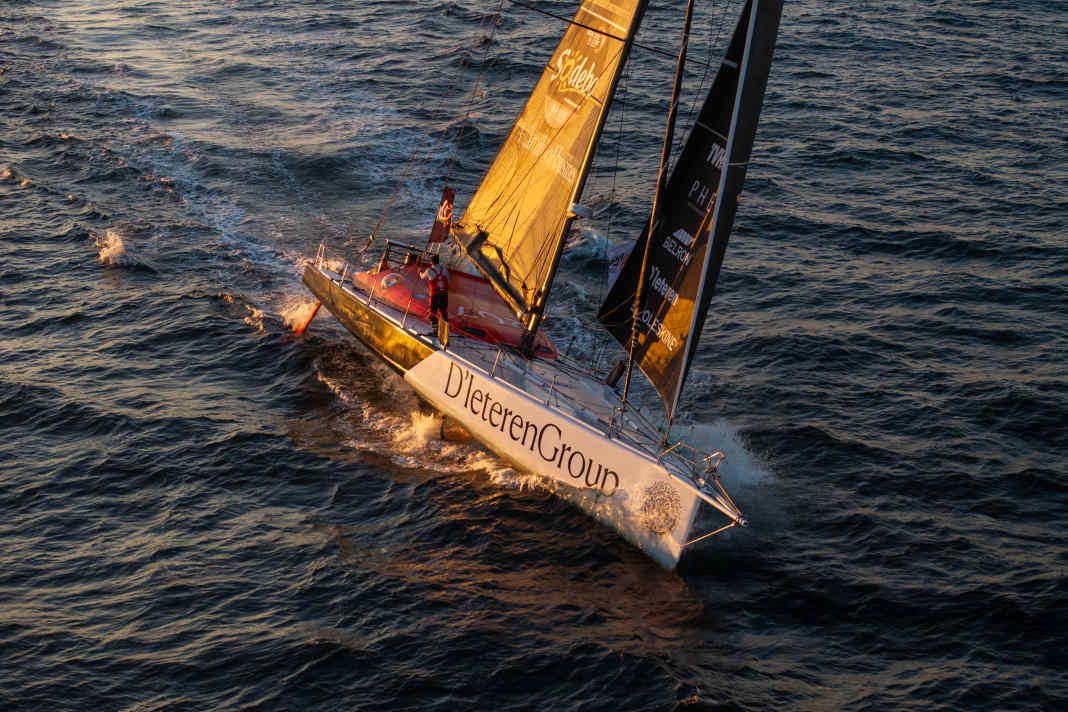



The tenth edition of the legendary Vendée Globe has come to an end. But for the last skipper still in the race, Denis Van Weynbergh, the end came around two days too early. The 57-year-old Belgian on his IMOCA 60 "D'Ieteren Group", built in Hungary in 2013, was just a tiny one per cent too slow to reach the time limit.
"I do between 80 and 100 miles a day, it's complicated and depressing. I feel like a prisoner whose sentence is constantly being extended by several days and that there is a whole series of challenges to overcome to get out of prison... I admit that I'm really tired," Van Weynbergh said yesterday.
How the time limit came about
The finish line at Les Sables-d'Olonne was closed at 8am this morning, 52 days after Charlie Dalin's triumph. The Frenchman had finished his race already ended on 14 January. The time limit therefore adds more than 80 per cent to the winning time. The time limit is based on the duration of the race that the winner of the ninth Vendée Globe needed for his solo race around the world: The Finn Ari Huusela travelled 116 days, 18 hours, 15 minutes and 46 seconds on "Stark" in 2020/2021. The time limit was introduced in 2020 to emphasise the sporting nature of the Vendée Globe more clearly and make the race more predictable for the organisers.
Only 1 per cent too slow
At the time the race closed this morning, Denis Van Weynbergh still had just over 200 nautical miles to go to the finish line, after 23,687 nautical miles sailed. In the past few hours, he only managed 112.7 nautical miles with an average speed to the finish of 3.7 knots. He is expected to arrive tomorrow night. After almost four months at sea, he is now only around two days away.
Technical problems in recent weeks had slowed him down considerably. Most recently, the mainsail halyard broke and at times he was only under genoa or triple reefed main on the road.
Prize money is divided up
In this case, one man's sorrow is another man's joy, even if it's only peanuts. If Van Weynbergh had made it to the finish in time, he would have been entitled to prize money of 4,347.82 euros - as would all the skippers from eleventh place upwards, including the German Boris Herrmann. As the Belgian missed the time limit, the prize money will be split between the others, increasing their prize money to 4,545.45 euros.
Technological divide
The Vendée Globe 2024 impressively demonstrated the dominance of foiling technology in this single-handed ocean race. After years of development, the boats with hydrofoils proved to be superior in all conditions and significantly improved the record for the circumnavigation.
At the front of the race, Charlie Dalin and Yoann Richomme fought a thrilling duel that kept the spectators enthralled until the end. Both skippers showed an aggressive driving style and repeatedly took risks to gain an advantage. Their duel was exemplary of the overall very high standard of the top 10, who were able to clearly set themselves apart from the rest of the field.
According to experienced skipper Vincent Riou, the large lead of almost a week between the first three boats and the pursuers is mainly due to the weather conditions and the courage of the leaders to cross a very active front in the Indian Ocean. "This time they had the machines to do it," said the Frenchman. The improved performance of the foilers in downwind conditions made the difference.
"In 2020, we were still at the beginning of the big foils and everyone was in the unknown," says Riou. "But the experience we've gradually gained and the human and financial resources of the big teams have helped to make the latest generation of boats much more mature."
The gap between the top boats and the older yachts with straight centreboards, such as Denis Van Weynbergh's, has widened further. The Vendée Globe, often referred to as the "Everest of the seas", is therefore facing a fascinating development.
The DNA of the Vendée Globe
The origins of this phenomenon go back to the first event in 1989. At that time, Jean-François Coste started with a Pen Duick III from 1967, while other participants were already using yachts specially designed for the race.
To this day, despite these technological differences, one element remains unchanged: the enthusiasm of all participants for the ultimate challenge of single-handed sailing around the world. This passion unites professionals and amateurs, high-tech yachts and classic sailing boats. It is what makes the Vendée Globe more than just a competition for speed and records.
This duality makes the Vendée Globe a unique event in international sailing. It combines cutting-edge technology and nautical tradition, speed records and personal borderline experiences. It is precisely this diversity that is the key to the enduring fascination and success of the regatta.

